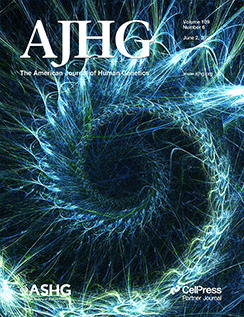Bi-allelic deleterious variants in SNAPIN, which encodes a retrograde dynein adaptor, cause a prenatal-onset neurodevelopmental disorder.
IF 8.1
1区 生物学
Q1 GENETICS & HEREDITY
引用次数: 0
Abstract
Fetal brain anomalies identified by prenatal ultrasound and/or magnetic resonance imaging represent a considerable healthcare burden with ∼1-2/1,000 live births. To identify the underlying etiology, trio prenatal exome sequencing or genome sequencing (ES/GS) has emerged as a comprehensive diagnostic paradigm with a reported diagnostic rate up to ∼32%. Here, we report five unrelated families with six affected individuals that presented neuroanatomical, craniofacial, and skeletal anomalies, all harboring rare, bi-allelic deleterious variants in SNAPIN, which encodes SNARE-associated protein. SNAPIN is a ubiquitously expressed component of the autophagy-lysosomal pathway that catalyzes retrograde axonal transport and synaptic transmission. To investigate the role of SNAPIN in brain development, we generated zebrafish gene ablation models, which recapitulated human-relevant disease phenotypes. Two independent, genetically stable snapin mutants exhibited pre-adulthood lethality, reduced overall length, disproportionately smaller head size, and altered brain morphology. Transcriptomic profiling of snapin mutant zebrafish heads revealed an early and progressive transcriptomic shift marked by autophagy activation with concomitant downregulation of structural and neurodevelopmental genes. Assessment of brain cellular ultrastructure with electron microscopy and light chain 3 (LC3)-II immunoblotting revealed retrograde vesicle transport defects, with an accumulation of late endosomes and autophagosomes. Together, these findings support bi-allelic pathogenic variants in SNAPIN as a likely cause for a severe neurodevelopmental syndrome and expand the growing list of autophagy-lysosome pathway regulators essential for human brain development.编码逆行动力蛋白适配体的SNAPIN的双等位基因有害变异会导致产前发病的神经发育障碍。
产前超声和/或磁共振成像发现的胎儿脑异常代表了相当大的医疗负担,约1 / 2/ 1000活产。为了确定潜在的病因,三人产前外显子组测序或基因组测序(ES/GS)已成为一种综合诊断范例,据报道诊断率高达32%。在这里,我们报告了5个不相关的家庭,其中6个受影响的个体表现出神经解剖、颅面和骨骼异常,所有这些都在编码snare相关蛋白的SNAPIN中携带罕见的双等位基因有害变异。SNAPIN是自噬-溶酶体途径中普遍表达的成分,催化轴突逆行转运和突触传递。为了研究SNAPIN在大脑发育中的作用,我们建立了斑马鱼基因消融模型,该模型再现了与人类相关的疾病表型。两种独立的、基因稳定的snap蛋白突变体表现出成年前的致命性、总长度减少、不成比例的头大小缩小和脑形态改变。对snapin突变斑马鱼头部的转录组分析显示,自噬激活伴随着结构和神经发育基因的下调,这是一种早期和进行性的转录组转变。用电镜和轻链3 (LC3)-II免疫印迹检测脑组织超微结构显示逆行性囊泡运输缺陷,并伴有晚期核内体和自噬体的积累。总之,这些发现支持SNAPIN的双等位致病变异可能是严重神经发育综合征的原因,并扩大了人类大脑发育所必需的自噬-溶酶体途径调节因子的不断增长的列表。
本文章由计算机程序翻译,如有差异,请以英文原文为准。
求助全文
约1分钟内获得全文
求助全文
来源期刊
CiteScore
14.70
自引率
4.10%
发文量
185
审稿时长
1 months
期刊介绍:
The American Journal of Human Genetics (AJHG) is a monthly journal published by Cell Press, chosen by The American Society of Human Genetics (ASHG) as its premier publication starting from January 2008. AJHG represents Cell Press's first society-owned journal, and both ASHG and Cell Press anticipate significant synergies between AJHG content and that of other Cell Press titles.

 求助内容:
求助内容: 应助结果提醒方式:
应助结果提醒方式:


